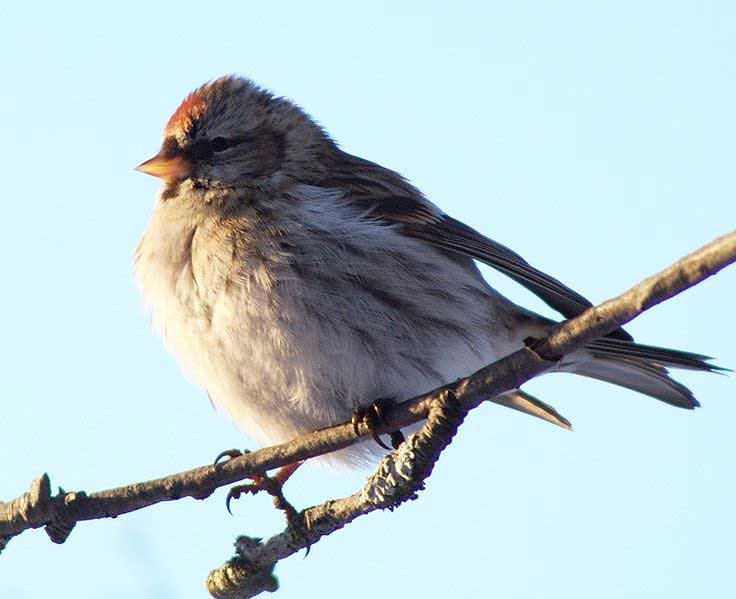
Acanthis hornemanni (*)
Superregnum: Eukaryota
Cladus: Unikonta
Cladus: Opisthokonta
Cladus: Holozoa
Regnum: Animalia
Subregnum: Eumetazoa
Cladus: Bilateria
Cladus: Nephrozoa
Superphylum: Deuterostomia
Phylum: Chordata
Subphylum: Vertebrata
Infraphylum: Gnathostomata
Megaclassis: Osteichthyes
Cladus: Sarcopterygii
Cladus: Rhipidistia
Cladus: Tetrapodomorpha
Cladus: Eotetrapodiformes
Cladus: Elpistostegalia
Superclassis: Tetrapoda
Cladus: Reptiliomorpha
Cladus: Amniota
Classis: Reptilia
Cladus: Eureptilia
Cladus: Romeriida
Subclassis: Diapsida
Cladus: Sauria
Infraclassis: Archosauromorpha
Cladus: Crurotarsi
Divisio: Archosauria
Cladus: Avemetatarsalia
Cladus: Ornithodira
Subtaxon: Dinosauromorpha
Cladus: Dinosauriformes
Cladus: Dracohors
Cladus: Dinosauria
Ordo: Saurischia
Cladus: Eusaurischia
Subordo: Theropoda
Cladus: Neotheropoda
Cladus: Averostra
Cladus: Tetanurae
Cladus: Avetheropoda
Cladus: Coelurosauria
Cladus: Tyrannoraptora
Cladus: Maniraptoromorpha
Cladus: Maniraptoriformes
Cladus: Maniraptora
Cladus: Pennaraptora
Cladus: Paraves
Cladus: Eumaniraptora
Cladus: Avialae
Infraclassis: Aves
Cladus: Euavialae
Cladus: Avebrevicauda
Cladus: Pygostylia
Cladus: Ornithothoraces
Cladus: Ornithuromorpha
Cladus: Carinatae
Parvclassis: Neornithes
Cohors: Neognathae
Cladus: Neoaves
Cladus: Telluraves
Cladus: Australaves
Ordo: Passeriformes
Subordo: Passeri
Infraordo: Passerida
Superfamilia: Passeroidea
Familia: Fringillidae
Subfamilia: Carduelinae
Genus: Acanthis
Species: Acanthis hornemanni
Subspecies: A. h. exilipes – A. h. hornemanni
Name
Acanthis hornemanni (Holböll, 1843)
Synonyms
Linota hornemanni (protonym)
Acanthis flammea hornemanni
Carduelis hornemanni
References
Naturhistorisk Tidsskrift. 4: 398.
Vernacular names
беларуская: Попельная чачотка
brezhoneg: Lineg an toundra
català: Passerell carpó-blanc
čeština: Čečetka bělavá
Cymraeg: Llinos bengoch yr Arctig
dansk: Hvidsisken
Deutsch: Polar-Birkenzeisig
English: Arctic Redpoll
Esperanto: Arkta flamkardelo
español: Pardillo Ártico
eesti: Hele-urvalind
فارسی: زلفقرمزی قطبی
suomi: Tundraurpiainen
føroyskt: Reyðskalli
français: Sizerin blanchâtre
Gaeilge: Deargéadan artach
Gaelg: Kione-jiarg Arctagh
עברית: תפוחית צפונית
hrvatski: Polarna juričica
magyar: Szürke zsezse
íslenska: Hrímtittlingur
italiano: Organetto artico
日本語: コベニヒワ
қазақша: Күл шекілдек
kalaallisut: Orpimmiutaq avannarleq
한국어: 쇠홍방울새
lietuvių: Poliarinis čimčiakas
latviešu: Gaišais ķeģis
монгол: Шунхан цэгцүүхэй
Nederlands: Witstuitbarmsijs
norsk nynorsk: Polarsisik
norsk: Polarsisik
polski: Czeczotka tundrowa
português: Pintarroxo-de-hornemann
русский: Тундряная чечётка
саха тыла: Хаар чооруоһа
davvisámegiella: Vilgesummolcizáš
srpskohrvatski / српскохрватски: Polarna juričica
slovenčina: Stehlík polárny
slovenščina: Polarni brezovček
српски / srpski: Поларна јуричица
svenska: Snösiska
Türkçe: Kuzey Kutbu keten kuşu
українська: Чечітка біла
Tiếng Việt: Sẻ xám Bắc cực
中文: 极北朱顶雀
The Arctic redpoll or hoary redpoll[1] (Acanthis hornemanni) is a bird species in the finch family Fringillidae. It breeds in tundra birch forest. It has two subspecies, A. h. hornemanni (Greenland or Hornemann's Arctic redpoll) of Greenland and neighbouring parts of Canada, and A. h. exilipes (Coues' Arctic redpoll), which breeds in the tundra of northern North America and the Palearctic. Many birds remain in the far north; some birds migrate short distances south in winter, sometimes travelling with common redpolls.[2]
The genus name Acanthis is from the Ancient Greek akanthis, a name for a small now-unidentifiable bird, and hornemanni commemorates the Danish botanist Jens Wilken Hornemann.[3] The name "arctic redpoll" is used in Europe and "hoary redpoll" in North America.
Description
The Arctic redpoll is similar in appearance to the common redpoll but generally paler. It may be distinguished from that species by the unstreaked pale rump patch and the uniformly pale vent area. The Greenland race is a very large, pale bird, with the male sometimes described as a "snowball", but both forms are pale with small beaks, white rumps and often more yellow than grey-brown tones in their plumage. They have black bibs, orangish forehead patches and two light-coloured stripes on each wing. The females are more streaked on their breasts, sides and rumps, but are still pale. Adults are about 12 to 14 centimetres (4.7 to 5.5 in) in length and weigh about 12 to 16 grams (0.42 to 0.56 oz).[4] Wingspan ranges from 20 to 25 cm.[5]
Behaviour
The Arctic redpoll is partially migratory and tends to move southwards in November and north again in March and April. It feeds mainly on seeds, particularly of alder and birch trees.[4]
Breeding takes place from May to July. The nest is built low down in a tree or bush and is neatly built with an outer layer of twigs, a middle layer of root fibres, fragments of juniper bark and lichens and an inner layer of down, willow buds and reindeer hair. Three to seven pale blue eggs with light reddish speckling are laid and incubated by the female. They hatch after about eleven days and the young fledge in about a further thirteen days.[4]
References
"Acanthis hornemanni". NatureServe Explorer An online encyclopedia of life. 7.1. NatureServe. Retrieved 13 December 2022.
"Hoary Redpoll: Life History". Cornell Lab of Ornithology. Retrieved 2 November 2020.
Jobling, James A. (2010). The Helm Dictionary of Scientific Bird Names. London, United Kingdom: Christopher Helm. pp. 29, 195. ISBN 978-1-4081-2501-4.
"Arctic Redpoll: Carduelis hornemanni". NatureGate. Retrieved 2013-12-13.
Oiseaux.net. "Sizerin blanchâtre - Acanthis hornemanni - Arctic Redpoll". www.oiseaux.net. Retrieved 2020-09-29.
Retrieved from "http://en.wikipedia.org/"
All text is available under the terms of the GNU Free Documentation License

